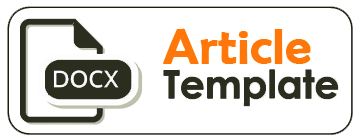- Picture Word Inductive Model (PWIM) : Assisting Students in Improving Their Writing Ability of Procedure Text
DOI:
https://doi.org/10.32528/ellite.v9i2.2989Keywords:
PWIM, Writing, Procedure textAbstract
The aims of this study are to know how to implement PWIM and also to find out whether the writing ability of procedure texts can be improved through PWIM. This study employed the classroom action research design, which was carried out in three cycles. This study included 25 ninth-grade students of MTs. Daarul Ulum Panyaungan in the academic year 2023-2024. Data for this study were collected through tests, diary notes, observation sheets, and questionnaires. The findings of the investigation suggest that, when employing PWIM, the teacher used eight phases that comprise: selecting an image; recognizing an image; labeling an image; reading and reviewing the picture word chart; adding words to the picture word chart; leading students to create a title; asking students to generate a sentence; and reviewing the sentence. The next finding showed that students’ scores improve from pre-research to the test. The students’ mean in test 1 was 57.8%, in test 2 was 63.4%, and in test 3 was 72.4%. Furthermore, based on diary notes, observation sheets, and questionnaire sheets, it was discovered that the teaching-learning process worked successfully. The study concludes that using PWIM as a learning medium increases students' capacity to produce procedure texts.
References
Abbas, A. M., & Tawfeeq, H. M. (2018). The Effects of Direct and Indirect Corrective Feedback on Accuracy in Second Language Writing. English Language Teaching. https://doi.org/10.5539/elt.v11n6p33
Aris, P., Ampa, A. T., & Sulfasyah, S. (2021). THE EFFECT OF PICTURE WORD INDUCTIVE MODEL (PWIM) ON THE STUDENTS’ ENGLISH WRITING ACHIEVEMENT AT JUNIOR HIGH SCHOOL. EXPOSURE : JURNAL PENDIDIKAN BAHASA INGGRIS. https://doi.org/10.26618/exposure.v10i1.4947
Bermillo, J. E., & Remollo, E. R. (2022). Picture Word Inductive Model (PWIM) on Students’ Vocabulary Achievement and Attitude. Indonesian Journal of Contemporary Education. https://doi.org/10.33122/ijoce.v4i1.24
Budiharto, R. A. (2019). NATIVE LANGUAGE INTERFERENCE ON TARGET LANGUAGE WRITINGS OF INDONESIAN EFL STUDENTS: AN EXPLORATORY CASE STUDY. Indonesian EFL Journal. https://doi.org/10.25134/ieflj.v5i1.1630
Burns, Anne. (1999). Collaborative Action Research for English Language Teachers. In Cambridge Language Teaching Library.
Calhoun, E. F. (1999). Teaching beginning reading and writing with the Picture Word Inductive Model. In Association of Supervision and Curriculum Development.
Celce-Murcia, M. (2001). Teaching Englih as a second or foreign language. In Teaching English as a second or foreign language.
Cresswell, J. W., Plano-Clark, V. L., Gutmann, M. L., & Hanson, W. E. (2003). Advanced mixed methods research designs. Handbook of Mixed Methods in Social and Behavioral Research.
Evans, N. W., Hartshorn, K. J., McCollum, R. M., & Wolfersberger, M. (2010). Contextualizing corrective feedback in second language writing pedagogy. Language Teaching Research. https://doi.org/10.1177/1362168810375367
Harmer, J. (2004). How to Teach Writing. In Overland.
Harmer, J. (2018). The Practice of English Language Teaching, 3rd Edition (Jeremy Harmer) (z-lib.org). In Overland.
Hemmati, F., & Soltanpour, F. (2012). A comparison of the effects of reflective learning portfolios and dialogue journal writing on iranian EFL learners’ accuracy in writing performance. English Language Teaching. https://doi.org/10.5539/elt.v5n11p16
Jaya, A., & Marleni, M. (2018). TEACHING READING PROCEDURE TEXT THROUGH CONCEPT ORIENTED READING INSTRUCTION (CORI) TO THE TENTH GRADE STUDENTS OF STATE SENIOR HIGH SCHOOL 13 PALEMBANG. English Community Journal. https://doi.org/10.32502/ecj.v2i1.1005
Jiang, P., Perkins, K. (2013). A Conceptual Paper on the Application of the Picture Word Inductive Model Using Bruner’s Constructivist View of Learning and the Cognitive Load Theory. Interdisciplinary Journal of Teaching and Learning.
Joni Saputra, B. (2021). THE EFFECT OF PICTURE-WORD INDUCTIVE MODEL STRATEGY ON STUDENTS’ WRITING SKILL IN DESCRIPTIVE TEXT. Inovasi Pendidikan. https://doi.org/10.31869/ip.v8i2.2992
Jupri. (2018). Using Video Recipe To Improve the Junior High. Journal of Languanges and Languange Teaching.
Mark Anderson. (2003). Text Types in English 1-2. In Text types in English. 2.
Meliasari, R., Ngadiso, N., & Marmanto, S. (2018). The Picture Word Inductive Model: Its Effectiveness to Teach Writing Viewed from Students’ Interest. International Journal of Language Teaching and Education. https://doi.org/10.22437/ijolte.v2i3.5697
Niño, F. L., & Páez, M. E. V. (2018). Building Writing Skills in English in Fifth Graders: Analysis of Strategies Based on Literature and Creativity. English Language Teaching. https://doi.org/10.5539/elt.v11n9p102
Nunan, D., Terrell, T. D., & Brown, H. D. (2003). PRACTICAL ENGLISH LANGUAGE TEACHING, FIRST EDITION. In Language.
Oktafiani, D., & Husnussalam, H. (2021). IMPROVING STUDENTS’ WRITING SKILLS IN DESCRIPTIVE TEXT USING PICTURE WORD INDUCTIVE MODEL (PWIM) STRATEGY. PROJECT (Professional Journal of English Education). https://doi.org/10.22460/project.v4i3.p420-425
Richards, J. C. (2011). Theories of Teaching in Language Teaching. In Methodology in Language Teaching. https://doi.org/10.1017/cbo9780511667190.004
Rosyada, A., & Febriyanti, R. H. (2020). Evaluating PWIM and GTM in Teaching English Basic Structure for EFL Undergraduates. Tadris: Jurnal Keguruan Dan Ilmu Tarbiyah. https://doi.org/10.24042/tadris.v5i2.6216
Sinurat, J. D. (2019). THE APPLICATION OF PICTURE WORD INDUCTIVE MODEL (PWIM) TO IMPROVE STUDENTS’ ACHIEVEMENTS IN WRITING DESCRIPTIVE TEXT. Journal MELT (Medium for English Language Teaching). https://doi.org/10.22303/melt.2.2.2017.111-125
Downloads
Published
Issue
Section
Categories
License
Copyright (c) 2024 Siti Sulhah Sulhah, Yayu Heryatun, Fadilla Oktaviana

This work is licensed under a Creative Commons Attribution 4.0 International License.






